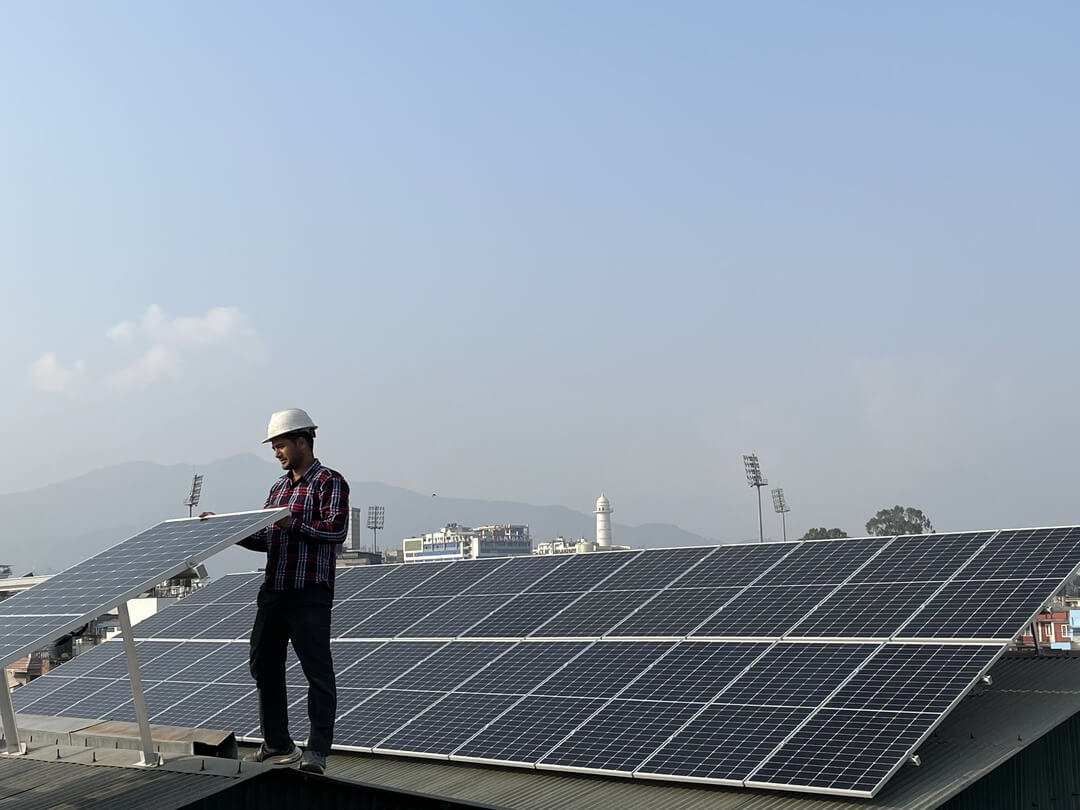Here comes the sun
Solar energy is suddenly looking much more attractive after recent floods destroyed hydropower plantsThe Bhote Kosi flood this month was a stark warning of the increased risk to Nepal’s hydropower plants due to climate breakdown, and the disaster has prompted a rethinking into solar energy options.
Nepal has pursued an energy strategy that relies almost totally on hydroelectricity, but grid-scale solar power is becoming cheaper and offers a viable alternative.
Solar energy accounts for a mere 0.1% of Nepal’s total installed generation of nearly 3,800MW. The rest of the world can now afford solar power because of China’s production. The price of solar panels has gone down by up to 90% in the past decade.
“One advantage of solar over hydro is the speed at which projects can be set up,” says Kushal Gurung of WindPower, “a 100MW hydro might take ten years to build, while a solar plant of the same capacity can be set up in six months.”
Landslides, floods and earthquakes frequently damage hydropower stations. The Rasuwa flood last week affected 230MW of generation capacity from four plants along the Trisuli. Last September’s flood badly damaged the 456MW Upper Tama Kosi.
The Nepal Electricity Authority (NEA) and private power producers lost much revenue, and Nepal had to stop exporting monsoon surplus electricity to India last year. Damaged solar projects, on the other hand, can be up and running after repairs within a few weeks.
“The main limitation of solar is land,” explains Gurung. “While a relatively small hydro project can generate 5-10MW pretty easily, a 1MW solar plant requires 500 m2 of land.”
Where the plant is situated matters as well. The best region is Mustang, because it gets the most solar radiation per unit area over a specific period. The Tarai may get a lot of sun but cloud cover, fog and pollution makes it less ‘irradiated’. The efficiency of a photovoltaic cell also drops, the higher the ambient temperature.
“A 1kW panel in Mustang might give you 6-7 units per day, while the same panel in the Tarai would give you half that,” says Gurung.

Another advantage for solar in Nepal is how decentralised it can be. An unreliable grid and difficult terrain make it hard to build hydropower stations and transmission lines, but home solar systems can be set up easily and provide reliable energy especially when paired with batteries for morning and the night.
Hydropower dams submerge large tracts of fertile valleys, impact ecosystems and displace people. But NEA and energy producers are locked into hydro, and are reluctant to shift to solar.
GhamPower is moving into solar in a big way, offering strategic funding to make panels available to poorer communities, and setting up solar microgrids.
The company was one of ten winners, out of 2,500 applicants, of the $50,000 Keeling Curve Prize which honours high-impact clean energy solutions.
The company sets up solar water pumps for farmers so that they can access water from boring wells year-round. It also set up solar systems that can power equipment needed during and after birthing such as baby warmers, incubators, sterilisers in remote health posts.
“Industries generally have large, unused rooftop spaces ideal for solar systems that can help reduce electricity bills,” says Pradip Humagain at Gham Power but points out a flaw in national policy, which caps the capacity of a solar power plant for a particular industry at 1MW. “This limitation makes no sense, and removing it would actually help the NEA by making them better able to provide electricity to industry.”
Nepal’s energy mix should be expanded to other renewables like solar, wind and even geothermal to reduce the risk of catastrophic damage to hydropower generation in future glacial floods. Reverse metering would allow solar producers to sell electricity to the grid, and time-of-day tariff would balance load.
“Our energy policy is heavily biased: 90% hydro, and 10% ‘other’,” says Gurung, “we should aim for at least 30% solar.”
Net metering involves solar rooftop systems that are connected to the grid, which would allow people to ‘export’ surplus energy generated during the day. This would offset the price of electricity the household uses at other times of the day, and the grid would essentially be like a battery.
But NEA is fixated on hydro and has opposed net metering for decades, seeing it as a threat. The government actually passed a net metering policy in 2018, but the NEA never properly adopted it.
In fact, despite hardly any solar energy systems that allow net metering having been installed, the NEA changed it to a ‘net billing’ system that makes exported energy cheaper than energy used in the home instead of a 1:1 offset.
Then the NEA quietly dropped all net metering in July 2022. This blindsided consumers and developers who had implemented such systems, the distrust scared away potential future investors.
The technology is affordable, but solar energy needs political will in Nepal. The policy should be to generate as much renewable energy as possible, instead of making solar and hydro compete.
Even more efficient than solar energy is wind power. In terms of area needed, wind is even more cost-effective, and much easier to set up than hydro.
India and China are already the biggest producers of wind turbine blades. Even though Nepal lacks coastlines where wind power is most efficient, there are places in the trans-Himalaya where it is viable. The only problem is the lack of roads, says Gurung.
This article is brought to you by Nepali Times, in collaboration with INPS Japan and Soka Gakkai International, in consultative status with UN ECOSOC.

writer




